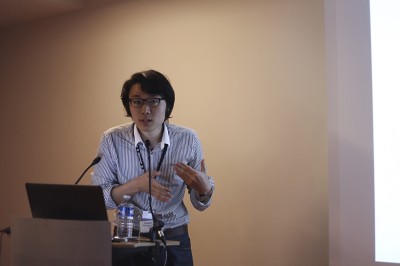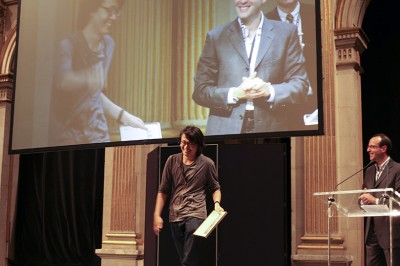Dongeek Shin, Ahmed Kirmani, Vivek K Goyal, and Jeffrey H. Shapiro, received the Best Paper Award at the IEEE International Conference on Image Processing (ICIP) 2014 held in Paris, France, for their paper “Computational 3D and Reflectivity Imaging with High Photon Efficiency.” This paper was awarded top prize from a pool of 1219 accepted papers, with nearly 3000 papers submitted.

The researchers developed a low-light imaging algorithm that is similar in flavor to the first-photon imaging (FPI) algorithm, but one that can be naturally and efficiently applied with array-based sensing. The team demonstrated that the proposed algorithm is able to reconstruct centimeter-accurate 3D and high-resolution reflectivity images at extremely low light levels, when the average number of photons detected at a sensor pixel is close to 1.
High quality 3D and reflectivity imaging using such minuscule amounts of light is incredibly difficult. The amount of light detected is accurately described using photon counts. Traditional 3D and reflectivity imaging methods do not accurately model this quantum effect of light detection, so applying them at low light levels gives images that are highly corrupted by artifacts.
The first-photon imaging (FPI) framework is a recently published collaboration between MIT’s Signal Transformation and Information Representation Group and Optical and Quantum Communications Group. FPI allows high resolution 3D and reflectivity imaging using only one detected photon at every image pixel. The FPI algorithm achieves such high photon efficiency as it accurately models the first-photon detection statistics, while exploiting spatial correlations existing in natural scenes. Using the time of the first-photon detection implies that the acquisition time is random at a pixel. This makes FPI suitable for imaging setups that use raster-scanners, not arrays of optical sensors that allow fast signal acquisition, as pixels are measured in parallel. The work presented at ICIP derives the statistics of individual photon arrivals given an array of optical sensors and presents an algorithm for accurate 3D and reflectivity reconstruction.

Due to its high photon efficiency, the research reported at ICIP can be used in applications that require high quality imaging at low light levels. Fast and accurate biological fluorescence imaging is one example, as very low levels of light are critical for imaging biological samples; biological samples can be damaged upon exposure to higher light levels. This framework can also drastically reduce the signal acquisition time for kilometer-range imaging and can be adapted to military applications and low-power sensing for drones that use 3D cameras.
Lead author Dongeek Shin is currently a RLE PhD student co-advised by Professor Vivek Goyal and Professor Jeffrey Shapiro at MIT EECS developing low-light 3D imaging algorithms. Shin received his SM degree from MIT in June 2014 and part of his SM research contributed to this ICIP work and publication.
Related Links:
Computational 3D and Reflectivity Imaging with High Photon Efficiency (Link to paper)
